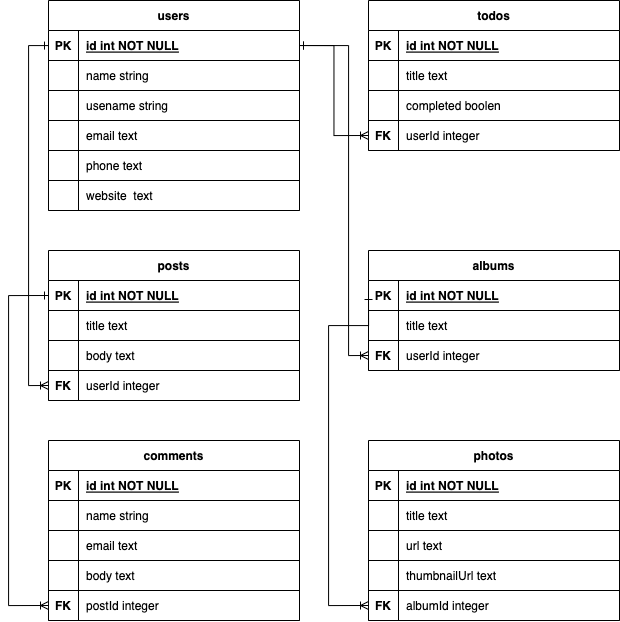哈囉,大家好!
愉快的週末就要來做些廢廢的事情,如練習語法?
接續前兩日的研究,目前被翻爛的書知道了能用JSONPlaceholder來seeding sample data,也知道可選用適合的HTTP client parse JSON API,昨天也順利地seeding 了Post data。
今天則是想極致偷懶,讓seeding task 能自動根據attributes 去抓API response 相對的value,而前置作業是要先乖乖將各個Model 的attributes 定義好。根據Guide 下方列的資訊,目前有:
/posts/1/comments
/albums/1/photos
/users/1/albums
/users/1/todos
/users/1/posts
簡單畫一下其關聯圖:
好了後就開始來處理tables 的migration 囉:
create_table "albums", force: :cascade do |t|
t.string "userId"
t.text "title"
t.datetime "created_at", precision: 6, null: false
t.datetime "updated_at", precision: 6, null: false
end
create_table "comments", force: :cascade do |t|
t.integer "postId"
t.string "name"
t.text "email"
t.text "body"
t.datetime "created_at", precision: 6, null: false
t.datetime "updated_at", precision: 6, null: false
end
create_table "photos", force: :cascade do |t|
t.integer "albumId"
t.text "title"
t.text "url"
t.text "thumbnailUrl"
t.datetime "created_at", precision: 6, null: false
t.datetime "updated_at", precision: 6, null: false
end
create_table "posts", force: :cascade do |t|
t.integer "userId"
t.text "title"
t.text "body"
t.datetime "created_at", precision: 6, null: false
t.datetime "updated_at", precision: 6, null: false
end
create_table "todos", force: :cascade do |t|
t.integer "userId"
t.text "title"
t.boolean "completed"
t.datetime "created_at", precision: 6, null: false
t.datetime "updated_at", precision: 6, null: false
end
create_table "users", force: :cascade do |t|
t.datetime "created_at", precision: 6, null: false
t.datetime "updated_at", precision: 6, null: false
t.string "name"
t.string "username"
t.text "email"
t.text "phone"
t.text "website"
end
接著我們一樣先建立一個task 來一步步修改:
# 根據昨天的經驗,我們能先寫出一個基本版:
# Seeding post
url = 'https://jsonplaceholder.typicode.com/posts'
post_data = HTTParty.get(url).parsed_response
post_data.each do |post|
Post.create(userId: post["userId"], title: post["title"], body: post["body"])
end
puts "Seeding post completed"
# Seeding comment
url = 'https://jsonplaceholder.typicode.com/comments'
comment_data = HTTParty.get(url).parsed_response
comment_data.each do |post|
Comment.create(postId: comment["postId"], name: comment["name"], email: comment["email"], body: comment["body"])
end
puts "Seeding comment completed"
但由以上的兩個blocks 來看,如果我們要seeding 這六個Model 的data,就會有六個類似的blocks,且每個欄位都需要手動輸入column name 和response key,這離懶人高尚的境界相去甚遠...
因此,我想先將需要的table name、Model name、url 尾綴整理一下:
models = [ 'post' ] # 之後會擴充加入其他Models
# 1. 先處理Model name 的轉換
models.map do |model_name|
model_name = model_name.humanize # 能把首字大寫,但因為本身還是String,所以需要利用const_get 方法來轉換為Model name
model_name.class
end
> String < Object
models.map do |model_name|
model_name = Class.const_get(model_name.humanize)
model_name.class
end
> Class < Module
# 2. 再來處理url 的尾綴
url = "https://jsonplaceholder.typicode.com/#{model_name}s"
> "https://jsonplaceholder.typicode.com/posts"
接著我們要處理建立資料表時會自動帶入的欄位:[ "id", "created_at", "updated_at" ]
這裡可以用attributes.keys這方法來檢視:
models = [ 'post' ] # 懶人的最終目標是只想改這行 XD
models.map do |model_name|
model_class_name = Class.const_get(model_name.humanize)
model_attributes = model_class_name.new.attributes.keys
end
>>
[0] "id",
[1] "userId",
[2] "title",
[3] "body",
[4] "created_at",
[5] "updated_at"
# 來刪掉那些多餘的欄位
models = [ 'post' ]
models.map do |model_name|
model_class_name = Class.const_get(model_name.humanize)
model_attributes = model_class_name.new.attributes.keys - [ "id", "created_at", "updated_at" ]
end
>>
[0] "userId",
[1] "title",
[2] "body"
再來則是要處理API response 內多餘的keys & values,如users 因帶有address、company 等我暫時沒用到的keys,也就是User.attributes 沒有,若整包當成Model.create 的params 則會噴錯。
先給大家看看沒處理時的狀況:
models = [ 'user' ]
models.map do |model_name|
model_class_name = Class.const_get(model_name.humanize)
model_attributes = model_class_name.new.attributes.keys - [ "id", "created_at", "updated_at" ]
url = "https://jsonplaceholder.typicode.com/#{model_name}s"
response = HTTParty.get(url).parsed_response
response.each do |res|
model_class_name.create(res) # 整個response 丟進去
end
end
Traceback (most recent call last):
5: from (irb):66
4: from (irb):66:in `map'
3: from (irb):72:in `block in irb_binding'
2: from (irb):72:in `each'
1: from (irb):73:in `block (2 levels) in irb_binding'
ActiveModel::UnknownAttributeError (unknown attribute 'address' for User.)
讓我們再度利用上面model_attributes 的attributes 吧!並搭配ruby Hash 去掉keys 的方法except:
except(*keys) public
Returns a hash that includes everything except given keys.
models = [ 'user' ]
models.map do |model_name|
model_class_name = Class.const_get(model_name.humanize)
model_attributes = model_class_name.new.attributes.keys - [ "id", "created_at", "updated_at" ]
url = "https://jsonplaceholder.typicode.com/#{model_name}s"
response = HTTParty.get(url).parsed_response
response.each do |res|
keys_to_delete = res.keys - model_attributes
res = res.except(*keys_to_delete) # I'm here
model_class_name.create(res)
end
end
最後再加上fail 的驗證和puts seeding 的處理狀況,咱們就完成啦!
Apidock: const_get
Apidock: except(for hash)
# 偷懶完成品
models = [ 'post', 'comment', 'album', 'photo', 'todo', 'user' ]
models.map do |model_name|
model_class_name = Class.const_get(model_name.humanize)
model_attributes = model_class_name.new.attributes.keys - [ "id", "created_at", "updated_at" ]
url = "https://jsonplaceholder.typicode.com/#{model_name}s"
response = HTTParty.get(url).parsed_response
response.each do |res|
keys_to_delete = res.keys - model_attributes
res = res.except(*keys_to_delete)
model_class_name.create(res)
end
fail unless model_class_name.count == response.count
puts "Seeding #{model_name}s completed."
end
有沒有很懶呢?XD 希望大家都能成為怕麻煩的極致懶人~~!
